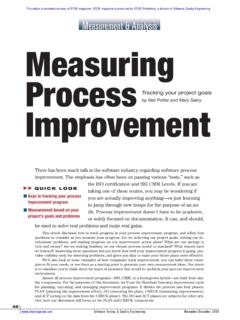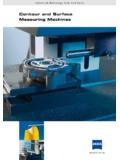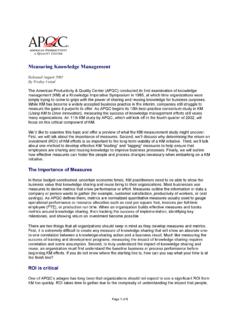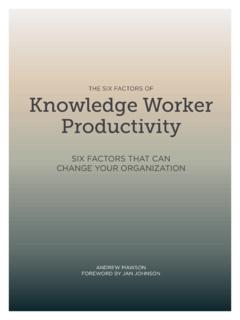Transcription of Criteria for measuring and comparing information …
1 Proceedings of the 30th information Systems Research Seminar in Scandinavia IRIS 2007 1 Criteria for measuring and comparing information systems Joel Palmius Mid Sweden University Abstract: Whether designing a new system or evaluating an old one it could be useful to be able to compare the system with another system , intended or existing. One way to evaluate and compare information systems would be through a set of Criteria encompassing factors thought important. For such Criteria to be useful they need to be operational and measurable.
2 This article presents a list of Criteria found in literature, combined with a few Criteria not found, and a categorization. The Criteria are presented in a collected hierarchical model organizing them into the categories of Organization, Individual, information , Technology and Systemics. It is concluded that the Criteria model may be useful, for example as a checklist during design, but that it needs to be operationalized, and be exposed to practice and empirics. Keywords: information system , evaluation, measurement, comparison, Criteria Introduction When confronted with an information system (IS) and an unspecific expectation to make the IS "better", it could be useful to measure the current IS and compare it with another IS, intended or existing.
3 With operational Criteria for measuring an information system , a foundation can be laid for improving the IS in the aspects of which it is found lacking. Palmius, J: Criteria for measuring and comparing information systems Proceedings of the 30th information Systems Research Seminar in Scandinavia IRIS 2007 2 Further, an information systems designer needs to know what the goal is, and a buyer of the services of the designer needs to know whether the goals have been fulfilled. With a set of Criteria for deciding this, there could be a checklist before, during and after a design phase: Does the system do what it is supposed to do, and to what extend does it do it as compared with, for example, a previous system ?
4 When searching for Criteria which characterize an information system , I have not yet been able to find a complete model which encompasses all the aspect I find interesting. In the literature section below, I will list those models I have found (and which are relevant for the discussion). The lack of encompassing models is part of what makes this article relevant: I have not found a usable overall model, and the models for measuring or evaluating details did not take each other into account when they were formulated.
5 A summary and reformulation is thus useful. Purpose of the article The purpose of this article is to provide a collected framework for Criteria for the measuring and comparing of information systems. Assumptions In the following discussion, a few assumptions will be held. First, the definition of what constitutes a good system varies between stakeholders, perspectives and system purposes. To paraphrase Ashby (1962), there is no information system which is good in an absolute sense. Second, because of the assumption of relativity, it is necessary to choose a perspective from which to conduct the discussion.
6 In this article a managerial perspective is chosen. Thirdly, it is assumed that a healthy information system will require that all stakeholders are reasonably satisfied. Thus even with a managerial perspective, we need to look at what is good for the participants in the information system . Terms In this article, an information system is all that, abstract or not, within an organization that contributes to and shapes the distribution of information . Humans are parts of the information systems rather than users of the information system .
7 There is no such thing as information system without a human, but it is perfectly conceivable to have an information system without a single computer. (Palmius J, 2005b) Other core terms used here are "evaluation", "measurement" and "comparison". The measurement is an observation and quantification of a phenomenon, as formulated in the Criteria list below. The evaluation is a measurement paired with Palmius, J: Criteria for measuring and comparing information systems Proceedings of the 30th information Systems Research Seminar in Scandinavia IRIS 2007 3 an observation of what would be desired (by the person doing the evaluation).
8 The comparison is putting two evaluations against each other. Method The procedure for producing the Criteria framework has been the following: First I started with a broad search on the net for terms such as good information system and evaluation of information system to find encompassing models fitting what I wanted (a model for the evaluation of information systems). This basically resulted in the DMSM (DeLone W, McLean E, 1992) mentioned more in detail below. Secondly I tried arranging Criteria according to time (pre-hoc measurement, normative statement, post-hoc evaluation), but decided it was not a good structure, because it was difficult to place Criteria .
9 Thirdly I drafted a rough hierarchy based on a organization-individual-technology-syste ms view and found that this made it easier to categorize Criteria . Along with finding new Criteria I placed them into the top categories, and made sub-categories from what to me seemed to be the major groups found in literature. Late in the work I moved all Criteria related to information from the organization category to a category of its own. Criteria from literature The following is a summary of what I find to be important literature for my purpose: To find a set of operational Criteria for evaluating IS in an organizational sense.
10 There are several models for evaluating information systems, and a plentitude of models for evaluating specific details within an IS. Searching on Google's aggregated article database ( ), one can see that most of the literature for evaluations falls within one of these categories: Economical benefit, such as return on investment Usability measurements, mainly of interfaces Measurements of user and/or customer satisfaction Literature also exists, but in significantly lesser degree, for measuring organizational benefits, systems quality and performance (for performance, lesser degree on an organizational level.)





